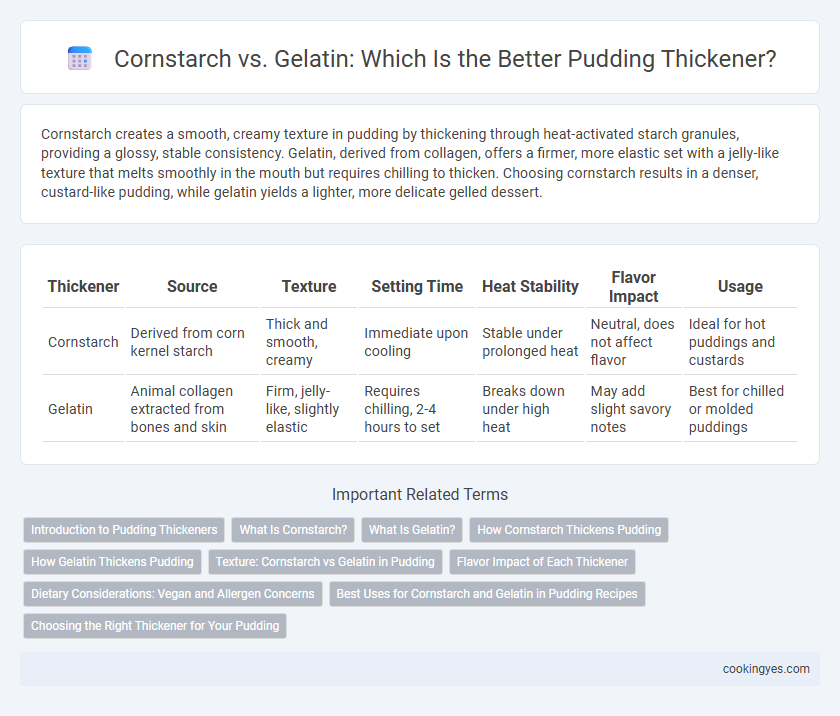Cornstarch creates a smooth, creamy texture in pudding by thickening through heat-activated starch granules, providing a glossy, stable consistency. Gelatin, derived from collagen, offers a firmer, more elastic set with a jelly-like texture that melts smoothly in the mouth but requires chilling to thicken. Choosing cornstarch results in a denser, custard-like pudding, while gelatin yields a lighter, more delicate gelled dessert.
Table of Comparison
| Thickener | Source | Texture | Setting Time | Heat Stability | Flavor Impact | Usage |
|---|---|---|---|---|---|---|
| Cornstarch | Derived from corn kernel starch | Thick and smooth, creamy | Immediate upon cooling | Stable under prolonged heat | Neutral, does not affect flavor | Ideal for hot puddings and custards |
| Gelatin | Animal collagen extracted from bones and skin | Firm, jelly-like, slightly elastic | Requires chilling, 2-4 hours to set | Breaks down under high heat | May add slight savory notes | Best for chilled or molded puddings |
Introduction to Pudding Thickeners
Cornstarch and gelatin are common pudding thickeners, each offering distinct textures and properties. Cornstarch creates a smooth, creamy consistency by swelling starch granules when heated, while gelatin provides a firm, gel-like set through protein coagulation as it cools. Choosing between cornstarch and gelatin depends on the desired pudding texture and dietary preferences.
What Is Cornstarch?
Cornstarch is a fine, powdery starch derived from the endosperm of corn kernels, commonly used as a thickening agent in puddings due to its ability to create a smooth, glossy texture. When heated with liquid, cornstarch gelatinizes, swelling and forming a gel that imparts a creamy consistency without altering the flavor profile. Unlike gelatin, which is animal-based and requires cooling to set, cornstarch remains stable under heat and produces a more fluid, pourable pudding.
What Is Gelatin?
Gelatin is a protein derived from collagen found in animal bones and connective tissues, commonly used as a gelling agent in pudding to create a smooth, firm texture. Unlike cornstarch, which thickens pudding through starch gelatinization when heated, gelatin sets by cooling and provides a translucent, elastic consistency. Gelatin is ideal for recipes requiring a delicate gel structure and a melt-in-the-mouth feel, enhancing the mouthfeel and stability of pudding without cloudiness.
How Cornstarch Thickens Pudding
Cornstarch thickens pudding through a process called gelatinization, where starch granules absorb water and swell upon heating, creating a smooth, creamy texture. As the mixture reaches around 95degC (203degF), the granules burst and release amylose, which forms a stable network that traps liquid, giving pudding its characteristic thickness. Unlike gelatin, cornstarch produces a glossy finish and provides a firmer consistency without altering the flavor.
How Gelatin Thickens Pudding
Gelatin thickens pudding by forming a network of protein molecules that trap water and create a gel-like structure, providing a smooth, elastic texture distinct from the opacity of cornstarch-thickened puddings. Unlike cornstarch, which thickens through starch granule swelling and gelatinization when heated, gelatin sets as it cools, requiring precise temperature control to avoid curdling or graininess. The molecular gelation properties of gelatin allow for clearer, more flexible pudding textures that hold shape well and melt smoothly on the palate.
Texture: Cornstarch vs Gelatin in Pudding
Cornstarch creates a creamy, smooth texture with a slightly opaque appearance, providing a sturdy yet soft pudding consistency. Gelatin yields a more delicate, jiggly texture with a clear, glossy finish, allowing for a firmer set that melts evenly on the palate. The choice between cornstarch and gelatin depends on whether you prefer a denser, silky pudding or a light, refined gel-like dessert.
Flavor Impact of Each Thickener
Cornstarch creates a smooth, creamy texture with a neutral flavor that allows the natural taste of pudding ingredients to shine without alteration. Gelatin imparts a more delicate, slightly bounce-like consistency and can add a subtle, sometimes slightly savory or mineral aftertaste that may influence the overall flavor profile. Choosing between cornstarch and gelatin ultimately affects both mouthfeel and the authentic flavor experience of the pudding.
Dietary Considerations: Vegan and Allergen Concerns
Cornstarch serves as an excellent vegan pudding thickener since it is plant-based and free from animal-derived ingredients, making it suitable for vegan and vegetarian diets. Gelatin, extracted from animal collagen, poses allergen concerns and is unsuitable for vegans, vegetarians, and those with certain dietary restrictions, such as kosher or halal diets. Choosing cornstarch avoids common allergens associated with gelatin alternatives while maintaining a smooth, creamy texture in pudding recipes.
Best Uses for Cornstarch and Gelatin in Pudding Recipes
Cornstarch works best as a pudding thickener when a smooth, creamy texture with a glossy finish is desired, making it ideal for traditional custards and fruit-flavored puddings. Gelatin excels in recipes requiring a firmer, gelled consistency, such as mousse-like puddings or layered desserts that need to hold their shape. Selecting cornstarch enhances a velvety mouthfeel and stability under heat, while gelatin provides a delicate set and a melt-in-the-mouth sensation best suited for chilled puddings.
Choosing the Right Thickener for Your Pudding
Cornstarch provides a smooth, creamy texture and is ideal for classic puddings with a glossy finish due to its ability to thicken at higher temperatures. Gelatin creates a firmer, jiggly consistency perfect for mousse-style pudding or desserts requiring a stable set. Selecting cornstarch ensures a custard-like pudding while gelatin offers a delicate, melt-in-your-mouth experience, depending on your desired texture and presentation.
Cornstarch vs Gelatin for pudding thickener Infographic

 cookingyes.com
cookingyes.com